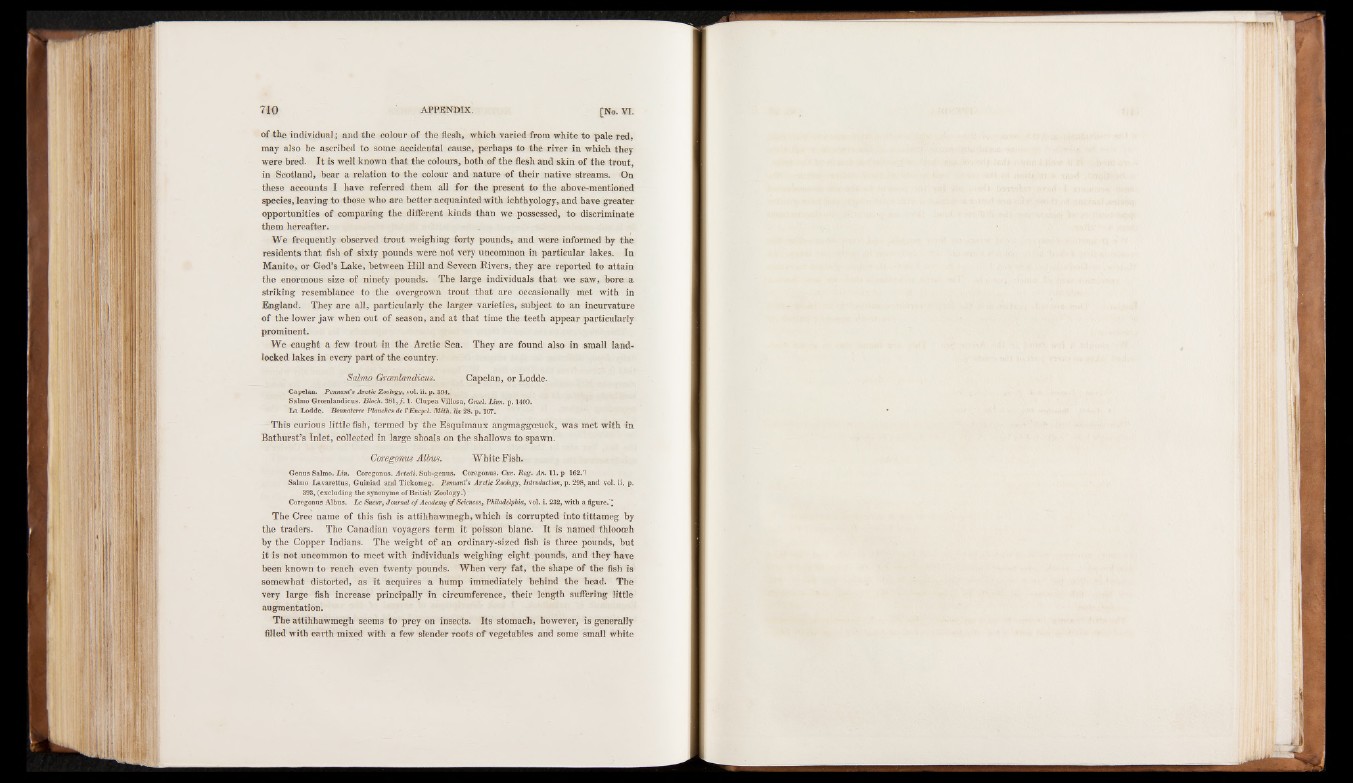
of the individual; and the colour of the flesh, which varied from white to pale red,
may also be ascribed to some accidental cause, perhaps to the river in which they
were bred. It is well known that the colours, both of the flesh and skin of the trout,
in Scotland, bear a relation to the colour and nature of their native streams. On
these accounts I have referred them all for the present to the above-mentioned
species, leaving to those who are better acquainted with ichthyology, and have greater
opportunities of comparing the different kinds than we possessed, to discriminate
them hereafter.
We frequently observed trout weighing forty pounds, and were informed by the
residents that fish of sixty pounds were not very uncommon in particular lakes. In
Manito, or God’s Lake, between Hill and Severn Rivers, they are reported to attain
the enormous size of ninety pounds. The large individuals that we saw, bore a
striking resemblance to the overgrown trout that are occasionally met with in
England. They are all, particularly the larger varieties, subject to an incurvature
of the lower jaw when out of season, and at that time the teeth appear particularly
prominent.
We caught a few trout in the Arctic Sea. They are found also in small landlocked
lakes in every part of the country.
Salmo Grtenlandicus. , Capelan, or Lodde.
Capelan. Pennant’s Arctic Zoology, vol. ii. p. 394.
Salmo Groenlandicus. Bloch. 381, ƒ. 1. Clupea Villosa, Gmel. Linn. p. 1409.
La Lodde. Bomaterre Planches de TEncycl. Méth. liv 28. p. 167.
This curious little fish, termed by the Esquimaux angmaggceuck, was met with in
Bathurst’s Inlet, collected in large shoals on the shallows to spawn.
Coregowus Albus. White Fish.
Genus Salmo. L in. Coregonus. Artedi. Sub-genus. Coregonus. Ctiv. R eg. A n. 11. p 162.'1
Salmo Lavarettus, Guiniad and Tickomeg. Pennant's Arctic Zoology, Introduction, p. 298, and vol. ii. p.
393, (excluding the synonyme of British Zoology.)
Coregonus Albus. L e Sueur, Journal o f Academy o f Sciences, Philadelphia, vol. i. 232, with a figure.' ~
The Cree name of this fish is attihhawmegh, which is corrupted into tittameg by
the traders. The Canadian voyagers term it poisson blanc. It is named thloooeh
by the Copper Indians. The weight of an ordinary-sized fish is three pounds, but
it is not uncommon to meet with individuals weighing eight pounds, and they have
been known to reach even twenty pounds. When very fat, the shape of thé fish is
somewhat distorted, as it acquires a hump immediately behind the head. The
very large fish increase principally in circumference, their length suffering little
augmentation.
The attihhawmegh seems to prey on insects. Its stomach, however, is generally
filled with earth mixed with a few slender roots of vegetables and some small white